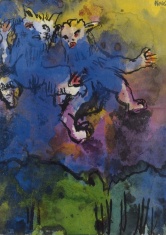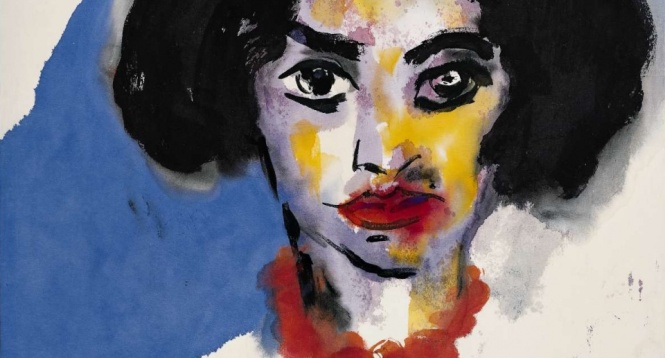This summer’s major exhibition at Louisiana is Emil Nolde. Nolde (1867-1956) is a classic – whether for his almost spontaneously combustible watercolors of poppies and other colorful natural phenomena or his distinctive expressionist love of the primitive, the simple.
But Nolde is not just a powerful colorist. His work is large and complex, and with the exhibition at Louisiana, which is assembled together with the Städel Museum in Frankfurt, visitors can experience the most comprehensive retrospective presentation of the painter in several decades – and thus also new dimensions of his work.
Nolde is a German artist, but his proximity to Denmark, both biographically and geographically, also makes him part of Danish art history. His influence has been great; he brought painting over the edge of the presentable into a violent, dramatic space where both religious passion and bodily ecstasy thrive and where his birthplace and the exotic in remote regions live side by side.
The exhibition is divided into 11 thematic chapters following a loose chronology, starting with Nolde’s EARLY WORKS and ending with UNPAINTED PICTURES.
The exhibition has been organized in collaboration with the Städel Museum in Frankfurt and the Nolde Foundation in Seebüll.
EARLY WORKS, TEMPESTS OF COLOUR, SEASCAPES
& BIBLICAL AND LEGEND PAINTINGS
Emil Nolde’s early creative phase begins with his extraordinary first work Mountain Giants from 1895-96. It clearly shows his enthusiasm for the imaginary and the grotesque as well as the importance of an immediate experience of nature, which inspired his fantastic motif. In 1901 the painter was attracted by Copenhagen and the Danish coast. There he represented the canals of the city in subdued colours and accomplished a number of highly abstract beach sceneries and seascapes.
These early works are influenced by Danish painting, especially by the work of the Skagen Painters: Nolde focused on the atmospheric quality of light and made a few reduced hues carry the atmosphere of the paintings. In the early years he also looked at the pictorial vocabulary of the Impressionists.
The artistic breakthrough comes with the flower and garden pictures, which for Nolde become the cue for experimentation with the potential of colour. These subjects, to this day considered particularly characteristic of him, can be seen in the exhibition’s second section, TEMPESTS OF COLOUR.
The next chapter SEASCAPES shows the series Autumn Sea (1910), which illustrates how Nolde comes close to abstraction. The raging sea remained one of his favourite subjects throughout his life. The foaming waves beneath the dramatic sky were painted on the Danish island of Als. His ‘studio’ was a wooden hut that the artist built directly on the beach.
There too Nolde painted some of his early Biblical and religious paintings, shown in the adjacent room in the section BIBLICAL AND LEGEND PAINTINGS. The religious subjects represent a zenith in his oeuvre. Nolde transforms scenes from the Old and New Testaments, for example Burial (1915) with its glowing colours and its flat application of paint.
BERLIN – FACETS OF A METROPOLIS, FASCINATING FOREIGN LANDS & MY GARDEN FULL OF FLOWERS
Nolde’s religious paintings are followed by his observations from Berlin, where from 1905 onwards he spent half the year. In the chapter BERLIN – FACETS OF A METROPOLIS masterworks of German Expressionism portraying the colourful night life of the metropolis like In the Coffeehouse (1911) or Dancer in a Red Dress (1910) are shown. For the first time these works are presented together with Nolde’s political and socially critical paintings such as Soldiers (1913) and Battlefield (1913). In Berlin too Nolde’s interest in non-European art and artefacts began. The painting Exotic Figures (Fetishes I) (1911) is based on drawings Nolde made of objects exhibited in the city’s ethnographic museum.
The chapter FASCINATING FOREIGN LANDS shows the works that were created during and after an expedition to New Guinea organized by the German Imperial Colonial Office. In the fiery splendour of colour of Tropical Sun (1914) from Nolde Stiftung Seebüll’s collection, one senses Nolde’s yearning for a natural idyll that is unspoiled by western civilization.
After the chapter on the South Sea come Nolde’s works from the years 1915-1932 under the heading MY GARDEN FULL OF FLOWERS. In this period the artist concentrates on the material offered by his native North Schleswig region, where he depicts the indomitable force of nature that is the sea, as well as the neatly laid out flower garden which he confronts, in works like Close Evening (1930), with the raw Nordic landscape. In addition he goes to work on the grand scale on varied, colourful flower watercolours – 20 watercolours in a compact hanging occupy a whole wall like a floral carpet.
MAGUS FROM THE NORTH, REGIONAL PAINTINGS,
LATE WORKS & UNPAINTED PICTURES
The section MAGUS FROM THE NORTH shows that alongside the flower pictures Nolde is mainly preoccupied in this period with fantastic subjects that clearly show the influence of the Swiss artist Arnold Böcklin; for example Sea Woman (1922). A watercolour like Animal and Woman (1931-1935) from the series Fantasies also belongs to the group of grotesque motifs.
After the Nazi seizure of power in 1933, which Nolde fully supported, he chose to a greater extent to use motifs from his native region in his paintings. The next chapter REGIONAL PAINTINGS gathers a selection of these oil paintings.
Now landscapes, seascapes and flower paintings typify the artist’s oeuvre. But to his great consternation his paintings are not received sympathetically, and in 1941 the artist is subjected to a Berufsverbot: he may no longer present his works in public nor sell them. Nevertheless Nolde continued to create paintings in large formats, including flower pictures like Large Poppies (Red, Red, Red) (1942). After the war Nolde not only regained his artistic freedom, he also won the recognition that he so fervently desired.
In his late oeuvre powerful nature and landscape pictures play a crucial role, as for example in Troubled Sea (1948) shown in the chapter LATE WORKS.
The last room gathers together a number of watercolours that have become known under the general title UNPAINTED PICTURES. These unusual watercolours were done by Nolde during the Nazi dictatorship from 1938 on. The very same year he began to transfer selected works from the series to canvas. Some of these paintings – for example Spring in Autumn (1940) – have never been shown in public before.
Emil Nolde BIOGRAPHY
Hans Emil Hansen was Emil Nolde’s birth name. He was born on 7 August 1867 in the village of Nolde near the German-Danish border. After primary school he was apprenticed as a woodcarver. In parallel with this he took lessons in drawing.
In 1892 he was employed as a teacher of colouring and decorative drawing at the Museum for Industries and Trade in St. Gallen. Since he achieved great financial success with mountain postcards in 1897 it became possible for him to move to Munich to try his hand as a painter.


















[…] Louisiana Museum of Modern Art || Exhibition: Emil Nolde (Retrospective) […]
LikeLike
[…] Louisiana Museum of Modern Art || Exhibition: Emil Nolde (Retrospective) […]
LikeLike